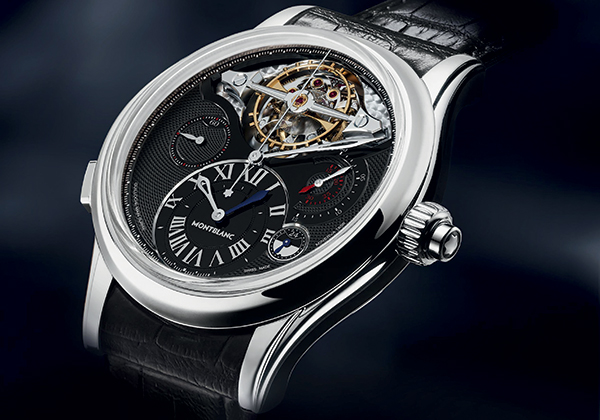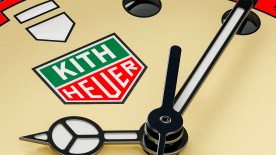The ExoTourbillon made its debut in 2010 in a watch that combines it with a magnificent chronograph. It’s a complex one, though, and doesn’t look anything like most other tourbillons. Is it too clever for its own good?
In 2010, Montblanc had entered its third year of full production of movements developed by its subsidiary, meanwhile renamed Institut Minerva. On this occasion, the Manufacture combined the chronograph – historically its foremost speciality – with one it had just adopted: the tourbillon. However, given the nature of Minerva as well as Montblanc’s keen awareness of its Manufacture’s intrinsic value, the tourbillon was unlike any other before it. As its name suggests, the ExoTourbillon is an external tourbillon – but external to what, exactly? A little explanation might not go amiss.
Outside
In the conventional architecture of this rotating regulating organ, the entire assembly (hairspring, balance, pallet-lever and escape wheel) is housed within a larger component that makes it rotate to counter the negative effects of gravity on running when it’s in a vertical position. This component is known as the tourbillon cage. It’s held in place by a lower bridge and (except for flying tourbillons) an upper bridge. In the ExoTourbillon, the balance has been placed outside this assembly (externally) above the cage – hence the ‘exo’ prefix. The balance remains driven by the tourbillon. As a result, it oscillates and in addition, rotates on its own axis, delivering all the expected benefits. Usually, the fact that the balance is the largest component in the assembly means that it dictates the size of the cage; removing it allows the cage to be that much smaller and in this instance, much more discreet.

It really does make sense
The ExoTourbillon offers a number of advantages compared to a traditional tourbillon. The fact that the cage is smaller means that it’s lighter and thus has less inertia. This in turn implies it requires less power to rotate – 30% less, apparently. In other words, the ExoTourbillon offers a rebuttal to all those who criticise tourbillons for being too heavy, creating too much friction, and being too power-hungry at the expense of the balance, which is the component that really needs energy. From a purely horological perspective, these arguments make sense, and it’s very much Minerva’s way to exploit any technical potential to the full. However, logic simply isn’t enough when it comes to tourbillons.
Defying all reason
The thing is, people who like wearing tourbillons rarely – if ever – buy them because they offer enhanced accuracy. In fact, they’re won over by just about everything else, firmly in the realms of the irrational and non-mechanical. Amongst these irrational arguments, one in particular has prevailed: tourbillons are characterised by their rotating cage and not just by having an oscillating balance, since many inexpensive ‘openheart’ watches also boast one of those. And the fact is that – just as on all Montblanc’s other ExoTourbillon movements – the first thing one notices about its Villeret 1858 ExoTourbillon Chronographe is the balance moving back and forth, rather than an instantly-recognisable cage constantly rotating in the same direction. What’s more, the speed of the rotation in question is very slow: one revolution every four minutes. The beautiful tourbillon bridge, with its rounded, polished arms and spade-shaped feet, undoubtedly stands out, but it looks just like a balance cock – a mundane feature rather than a crowning glory. It’s a classic case of perfect being the enemy of good. Although the ExoTourbillon may offer better performance, it fails to connect with its audience: the latter struggles to recognise it and understand its underlying principle.
Paradoxical
Worse still, the beauty of a movement with a tourbillon resides in the latter’s cage and bridge finish. These generally offer an indication of the construction quality of the rest of the movement, usually concealed beneath them. There’s no problem with Minerva’s work on the bridge, which is up to the brand’s usual magnificent standards. But the cage is tiny, and hidden beneath the balance. The wow effect that one might expect in a Minerva movement just isn’t there. Montblanc has however continued to exploit this tourbillon – not least by having made it much more affordable in the meantime, precisely because there’s no room to apply meticulous finishing. The upshot is that it doesn’t spend much time or attention on finishing here, thus bringing costs down. Even where it does put the work into a more painstaking finish, it doesn’t really pay off in the overall appearance of the piece, either. Despite Montblanc’s good intentions and the chronometric logic of the concept, the ExoTourbillon is perhaps best described as a great idea that wasn’t.
**This year GMT Magazine and WorldTempus have embarked on the ambitious project of summarising the last 20 years of the Tourbillon in The Millennium Watch Book - Tourbillons, a big, beautifully laid out coffee table book. This article is an extract. The Millennium Watch Book - Tourbillons is available on www.the-watch-book.com, in French and English.







